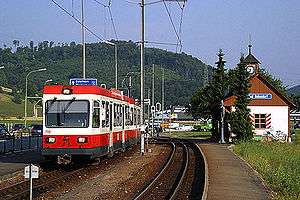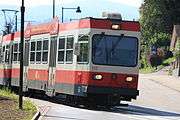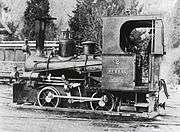Waldenburg railway
The Waldenburg railway (German: Waldenburgerbahn; WB) is a narrow-gauge light rail system in the canton of Basel-Landschaft. The 13.1-kilometre (8.1 mi) long[2] single-track line runs from Liestal, the capital of the canton, to Waldenburg, with stops in Bubendorf, Hölstein, Niederdorf, and Oberdorf. It connects to SBB train services in Liestal railway station.[2][3]
| Waldenburg railway | ||||||||||||||||||||||||||||||||||||||||||||||||||||||||||||||||||||||||||||||||||||||||||||||||||||||||||||||||||||||||||||||
|---|---|---|---|---|---|---|---|---|---|---|---|---|---|---|---|---|---|---|---|---|---|---|---|---|---|---|---|---|---|---|---|---|---|---|---|---|---|---|---|---|---|---|---|---|---|---|---|---|---|---|---|---|---|---|---|---|---|---|---|---|---|---|---|---|---|---|---|---|---|---|---|---|---|---|---|---|---|---|---|---|---|---|---|---|---|---|---|---|---|---|---|---|---|---|---|---|---|---|---|---|---|---|---|---|---|---|---|---|---|---|---|---|---|---|---|---|---|---|---|---|---|---|---|---|---|---|
 Stop at Bad Bubendorf | ||||||||||||||||||||||||||||||||||||||||||||||||||||||||||||||||||||||||||||||||||||||||||||||||||||||||||||||||||||||||||||||
| Overview | ||||||||||||||||||||||||||||||||||||||||||||||||||||||||||||||||||||||||||||||||||||||||||||||||||||||||||||||||||||||||||||||
| Locale | Switzerland, Canton of Baselland | |||||||||||||||||||||||||||||||||||||||||||||||||||||||||||||||||||||||||||||||||||||||||||||||||||||||||||||||||||||||||||||
| Termini | Liestal Waldenburg | |||||||||||||||||||||||||||||||||||||||||||||||||||||||||||||||||||||||||||||||||||||||||||||||||||||||||||||||||||||||||||||
| Operation | ||||||||||||||||||||||||||||||||||||||||||||||||||||||||||||||||||||||||||||||||||||||||||||||||||||||||||||||||||||||||||||||
| Opened | 1880 | |||||||||||||||||||||||||||||||||||||||||||||||||||||||||||||||||||||||||||||||||||||||||||||||||||||||||||||||||||||||||||||
| Owner | Baselland Transport | |||||||||||||||||||||||||||||||||||||||||||||||||||||||||||||||||||||||||||||||||||||||||||||||||||||||||||||||||||||||||||||
| Technical | ||||||||||||||||||||||||||||||||||||||||||||||||||||||||||||||||||||||||||||||||||||||||||||||||||||||||||||||||||||||||||||||
| Line length | 13.1 km (8.1 mi) | |||||||||||||||||||||||||||||||||||||||||||||||||||||||||||||||||||||||||||||||||||||||||||||||||||||||||||||||||||||||||||||
| Track gauge | 750 mm (2 ft 5 1⁄2 in) | |||||||||||||||||||||||||||||||||||||||||||||||||||||||||||||||||||||||||||||||||||||||||||||||||||||||||||||||||||||||||||||
| Electrification | 1500 V DC | |||||||||||||||||||||||||||||||||||||||||||||||||||||||||||||||||||||||||||||||||||||||||||||||||||||||||||||||||||||||||||||
| Maximum incline | 3.8% | |||||||||||||||||||||||||||||||||||||||||||||||||||||||||||||||||||||||||||||||||||||||||||||||||||||||||||||||||||||||||||||
| ||||||||||||||||||||||||||||||||||||||||||||||||||||||||||||||||||||||||||||||||||||||||||||||||||||||||||||||||||||||||||||||
Since 2016 the line is operated by Baselland Transport, and is, with the exception of a few industrial and funicular lines, the only line in Switzerland with a track gauge of 750 mm (2 ft 5 1⁄2 in). It was opened on 1 November 1880 and was operated by steam-hauled trains until 1953, when electric operation began.[2][3] BLT is rebuilding the line to use 1,000 mm (3 ft 3 3⁄8 in), with a planned completion in December 2022.
History

A concession was granted by the canton of Basel-Landschaft on 18 June 1871 for the construction of a narrow gauge railway from Liestal to Waldenburg and eventually further to Langenbruck. In 1873 the concession was altered to give the Swiss Central Railway the commission to build the railway. For financial reasons in 1876 the Swiss Central Railway requested a deadline extension. On 25 November 1879 the Waldenburgerbahn was founded as a separate company and took over the concession for the railway from Liestal to Waldenburg.
After only eight months' construction, the railway opened on 30 October 1880. Seats were provided in second- and third-class carriages. In 1881 the railway served eight stations with four journeys in each direction. The fastest journey over the whole 13 km line took 56 minutes.
In 1909 a committee made an application for the construction of and operation of an electric narrow-gauge railway from Waldenburg through Langenbruck to Balsthal, with a connection from St.Wolfgang to Mümliswil. The outbreak of World War I stopped plans for the extension of the line, and a 1912 proposal to electrify the line and regauge it to 1,000 mm (3 ft 3 3⁄8 in) gauge.
On 26 October 1953 electric operation of the railway began, using 1500 V DC. New rolling stock was acquired for this.
The current rolling stock, consisting of seven railcars and 10 control cars was acquired between 1986 and 1993, replacing the 1953 stock.
In late 2015, the government of Basel-Landschaft canton approved a plan to convert the line from 750 mm gauge to meter gauge in 2023.[4]. This will involve new passing loops and extensive reconstruction at Liestal and Waldenburg. The first step was the remodelling of Talhaus station (finished in 2018).[5] Fully automatic operation is also being contemplated.[6] Waldenburgerbahn AG merged into Baselland Transport in 2016.[7] In 2019 BLT ordered ten new light rail vehicles for use on the line after the conversion to metre gauge.[8]
Operation
The line is built to 750 mm (2 ft 5 1⁄2 in) gauge, and is electrified at 1500 V DC. For most of its route, the line takes the form of a single-track roadside electric tramway. There are 11 intermediate stops, and six passing loops.[3]
The journey over the whole line takes around 24 minutes. The line forms part of the Tarifverbund Nordwestschweiz (TNW) common fare network, and is numbered 19 in that network's publicity, but this number is not displayed on the vehicles. The line runs a half-hourly service throughout the day, with additional trains during peak hours. Tourist services were formerly operated from spring to autumn by the only operating steam locomotive on the line, 1902-built Number 5 Gédéon Thommen.[3][9][10][11][12] With the forthcoming conversion of the line to metre gauge, the "Thommen" was retired in September 2018 and is now in a new static display at Talhaus station
Rolling stock
Current rolling stock
| Image | Numbers | Notation | Year | Notes |
|---|---|---|---|---|
| 5 | G 3/3 | 1902 | Steam locomotive Gedeon Thommen; built by SLM; plinthed at Liestal station in 1961 but returned to working order in 1980; now used for tourist service[2][13] | |
| 11-17 | BDe 4/4 | 1985 to 1993 |
Bogie motor cars; 11-14 built in 1985-86; 15-17 in 1993 | |
 |
111-120 | Bt | 1985 to 1993 |
Bogie driving trailers; 111-114 built in 1985-86; 115-120 in 1993 |
| Four historic carriages; now used for tourist service | ||||
Former rolling stock
| Image | Numbers | Notation | Year | Notes |
|---|---|---|---|---|
 |
2 | G 2/2 | 1880 | Steam locomotive Rehhag; built by SLM; by 1913 in use on the construction of the Hauenstein Tunnel; ultimate fate unknown[14] |
 |
4 | G 3/3 | 1887 | Steam locomotive Waldenburg; built by SLM; out of service in 1910 and subsequently scrapped[15] |
| 4 | G 3/3 | Steam locomotive Langenbruck; in use up to electrification in 1953; ultimate fate unknown[13] | ||
| 6 | G 3/3 | 1912 | Steam locomotive Waldenburg; built by SLM; sold into preservation in 1954; now at the Swiss Museum of Transport in Lucerne[13] | |
| 7 | G 5/4 | 1938 | Steam locomotive; built by SLM; continued in use after electrification but scrapped in 1960[13] | |
.jpg) |
1-3 | CFe 4/4 BDe 4/4 |
1953 | Motor cars; out of service; scrapped |
References
- Eisenbahnatlas Schweiz [Swiss railway atlas] (in German). Schweers + Wall. 2012. p. 10. ISBN 978-3-89494-130-7.
- Buckley, Richard (2000). Tramways and Light Railways of Switzerland and Austria (2nd ed.). Gloucester, UK: Light Rail Transit Association. p. 119. ISBN 0-948106-27-1..
- Eisenbahnatlas Schweiz (in German). Verlag Schweers + Wall GmbH. 2012. p. 11. ISBN 978-3-89494-130-7.
- "Medienmitteilung Umspurung der Waldenburgerbahn". Basel Landschaft (in German). November 26, 2015.
- "Bahnhof Waldenburg" (PDF). Das BLT Magazin zur Erneuerung der Waldenburgerbahn (in German). No. 1. BLT Baselland Transport AG. 2017. pp. 5–7.
- Napoli, Sandro (December 11, 2018). "Automating Switzerland's Waldenburg Railway". International Railway Journal.
- "Die BLT und die Waldenburgerbahn fusionierten". Bahnonline.ch (in German). December 24, 2016. Retrieved January 1, 2020.
- "Baselbieter BLT bestellt zehn Stadler-Züge für 54 Millionen". bz (in German). April 26, 2019. Retrieved January 1, 2020.
- "Abfahrtszeiten ab Waldenburg Station Richtung Liestal Bahnhof" (PDF). Waldenburgerbahn AG (in German). Archived from the original (PDF) on January 28, 2015. Retrieved January 23, 2015.
- "Abfahrt Bahnhof Liestal" (PDF). Swiss Federal Railways (in German). Archived from the original (PDF) on January 23, 2015. Retrieved January 23, 2015.
- "Linienfahrpläne" (in German). Tarifverbund Nordwestschweiz. Archived from the original on February 25, 2015. Retrieved January 27, 2015.
- "Dampf- und Sonderzüge". Waldenburgerbahn AG (in German). Archived from the original on March 5, 2015. Retrieved January 23, 2015.
- Dickinson, Rob. "Switzerland's Waldenburgerbahn, 2010". The International Steam Pages. Retrieved January 26, 2015.
- Moſer 2006, p. 325.
- Moſer 2006, p. 331.
- Moſer, Alfred; et al. (2006). Der Dampfbetrieb der ſchweizeriſchen Eiſenbahnen 1847—2006. Ein abſchließendes, umfaſſendes Werk über ſämtliche Dampflokomotiven der ſchweizeriſchen Eiſenbahnen (in German) (7th ed.). ISBN 978-3-033-00948-6.
External links

- Official website (in German)